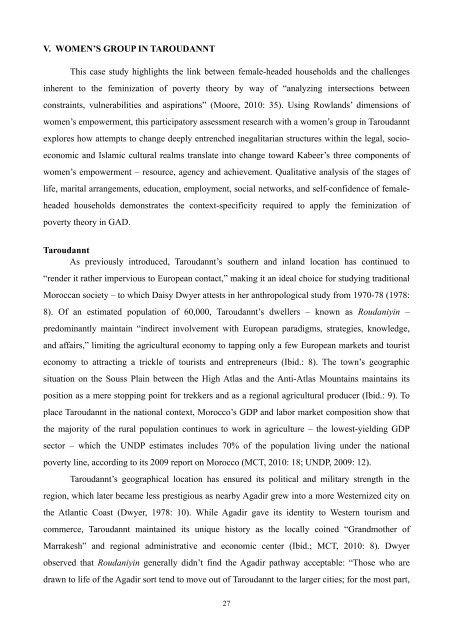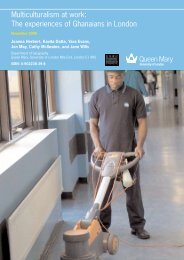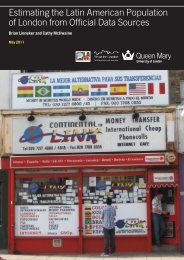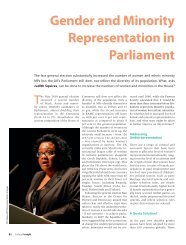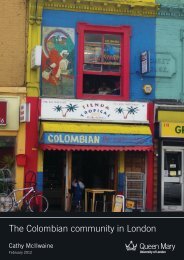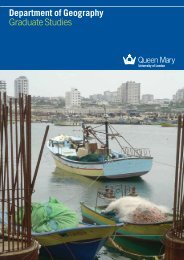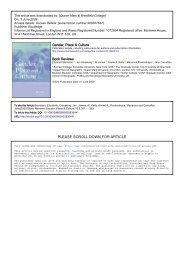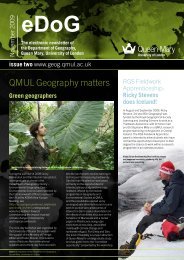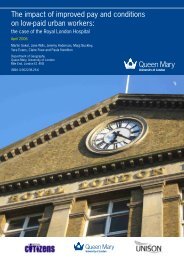Women's Empowerment and the Feminization of Poverty among
Women's Empowerment and the Feminization of Poverty among
Women's Empowerment and the Feminization of Poverty among
- No tags were found...
Create successful ePaper yourself
Turn your PDF publications into a flip-book with our unique Google optimized e-Paper software.
V. WOMEN’S GROUP IN TAROUDANNTThis case study highlights <strong>the</strong> link between female-headed households <strong>and</strong> <strong>the</strong> challengesinherent to <strong>the</strong> feminization <strong>of</strong> poverty <strong>the</strong>ory by way <strong>of</strong> “analyzing intersections betweenconstraints, vulnerabilities <strong>and</strong> aspirations” (Moore, 2010: 35). Using Rowl<strong>and</strong>s’ dimensions <strong>of</strong>women’s empowerment, this participatory assessment research with a women’s group in Taroudanntexplores how attempts to change deeply entrenched inegalitarian structures within <strong>the</strong> legal, socioeconomic<strong>and</strong> Islamic cultural realms translate into change toward Kabeer’s three components <strong>of</strong>women’s empowerment – resource, agency <strong>and</strong> achievement. Qualitative analysis <strong>of</strong> <strong>the</strong> stages <strong>of</strong>life, marital arrangements, education, employment, social networks, <strong>and</strong> self-confidence <strong>of</strong> femaleheadedhouseholds demonstrates <strong>the</strong> context-specificity required to apply <strong>the</strong> feminization <strong>of</strong>poverty <strong>the</strong>ory in GAD.TaroudanntAs previously introduced, Taroudannt’s sou<strong>the</strong>rn <strong>and</strong> inl<strong>and</strong> location has continued to“render it ra<strong>the</strong>r impervious to European contact,” making it an ideal choice for studying traditionalMoroccan society – to which Daisy Dwyer attests in her anthropological study from 1970-78 (1978:8). Of an estimated population <strong>of</strong> 60,000, Taroudannt’s dwellers – known as Roudaniyin –predominantly maintain “indirect involvement with European paradigms, strategies, knowledge,<strong>and</strong> affairs,” limiting <strong>the</strong> agricultural economy to tapping only a few European markets <strong>and</strong> touristeconomy to attracting a trickle <strong>of</strong> tourists <strong>and</strong> entrepreneurs (Ibid.: 8). The town’s geographicsituation on <strong>the</strong> Souss Plain between <strong>the</strong> High Atlas <strong>and</strong> <strong>the</strong> Anti-Atlas Mountains maintains itsposition as a mere stopping point for trekkers <strong>and</strong> as a regional agricultural producer (Ibid.: 9). Toplace Taroudannt in <strong>the</strong> national context, Morocco’s GDP <strong>and</strong> labor market composition show that<strong>the</strong> majority <strong>of</strong> <strong>the</strong> rural population continues to work in agriculture – <strong>the</strong> lowest-yielding GDPsector – which <strong>the</strong> UNDP estimates includes 70% <strong>of</strong> <strong>the</strong> population living under <strong>the</strong> nationalpoverty line, according to its 2009 report on Morocco (MCT, 2010: 18; UNDP, 2009: 12).Taroudannt’s geographical location has ensured its political <strong>and</strong> military strength in <strong>the</strong>region, which later became less prestigious as nearby Agadir grew into a more Westernized city on<strong>the</strong> Atlantic Coast (Dwyer, 1978: 10). While Agadir gave its identity to Western tourism <strong>and</strong>commerce, Taroudannt maintained its unique history as <strong>the</strong> locally coined “Gr<strong>and</strong>mo<strong>the</strong>r <strong>of</strong>Marrakesh” <strong>and</strong> regional administrative <strong>and</strong> economic center (Ibid.; MCT, 2010: 8). Dwyerobserved that Roudaniyin generally didn’t find <strong>the</strong> Agadir pathway acceptable: “Those who aredrawn to life <strong>of</strong> <strong>the</strong> Agadir sort tend to move out <strong>of</strong> Taroudannt to <strong>the</strong> larger cities; for <strong>the</strong> most part,27


